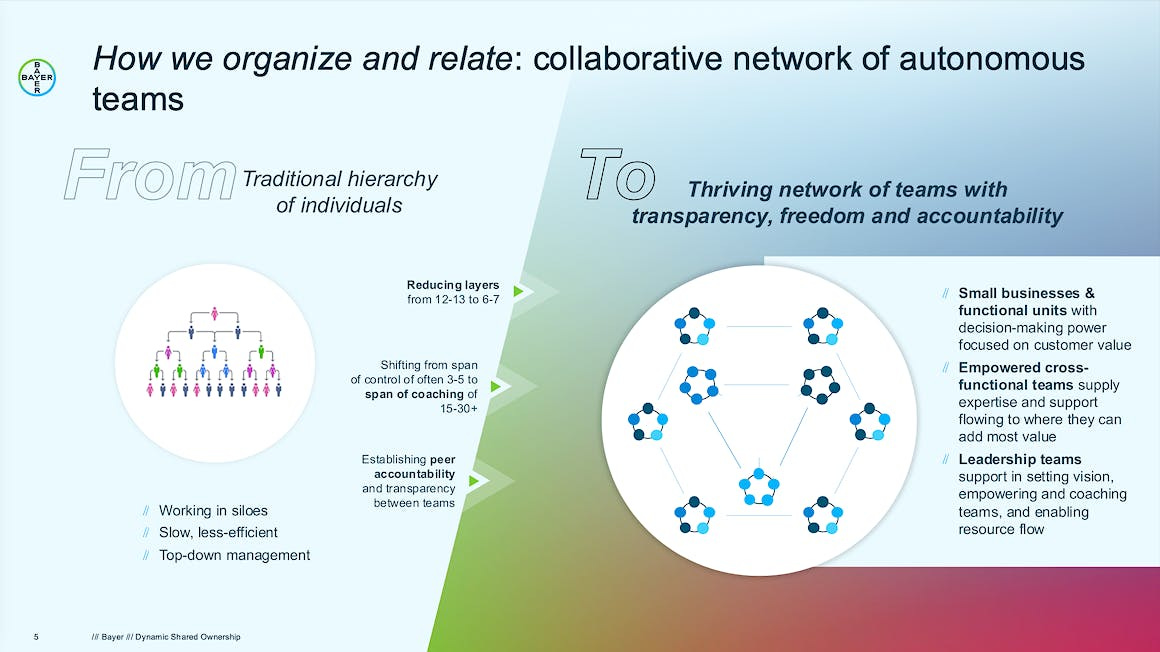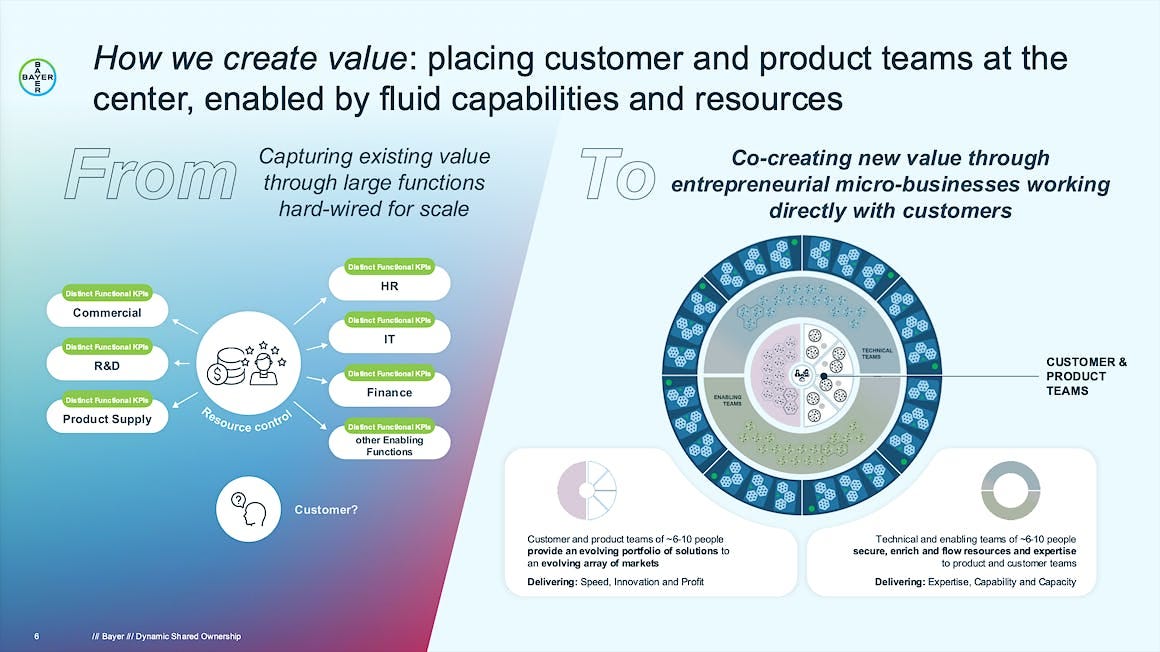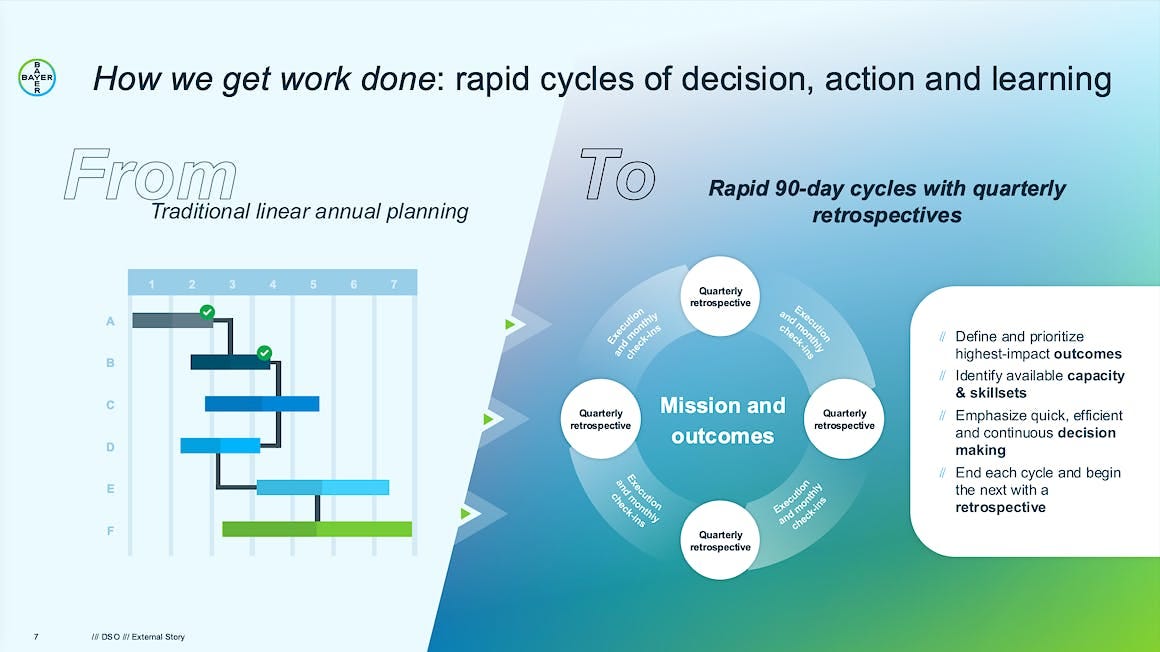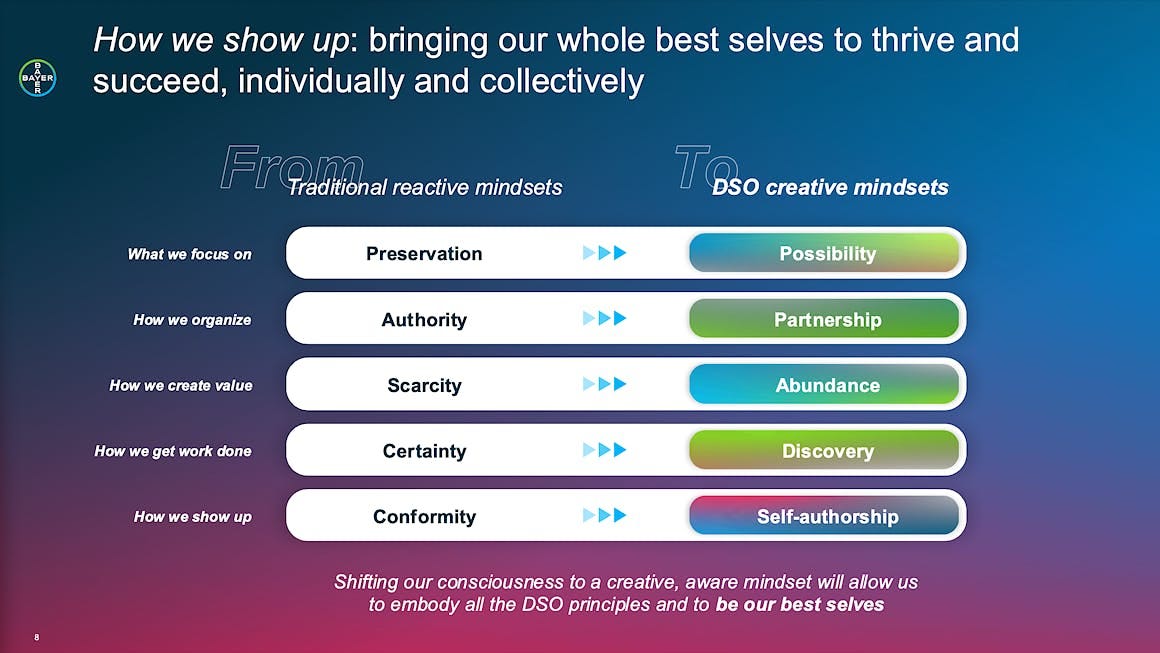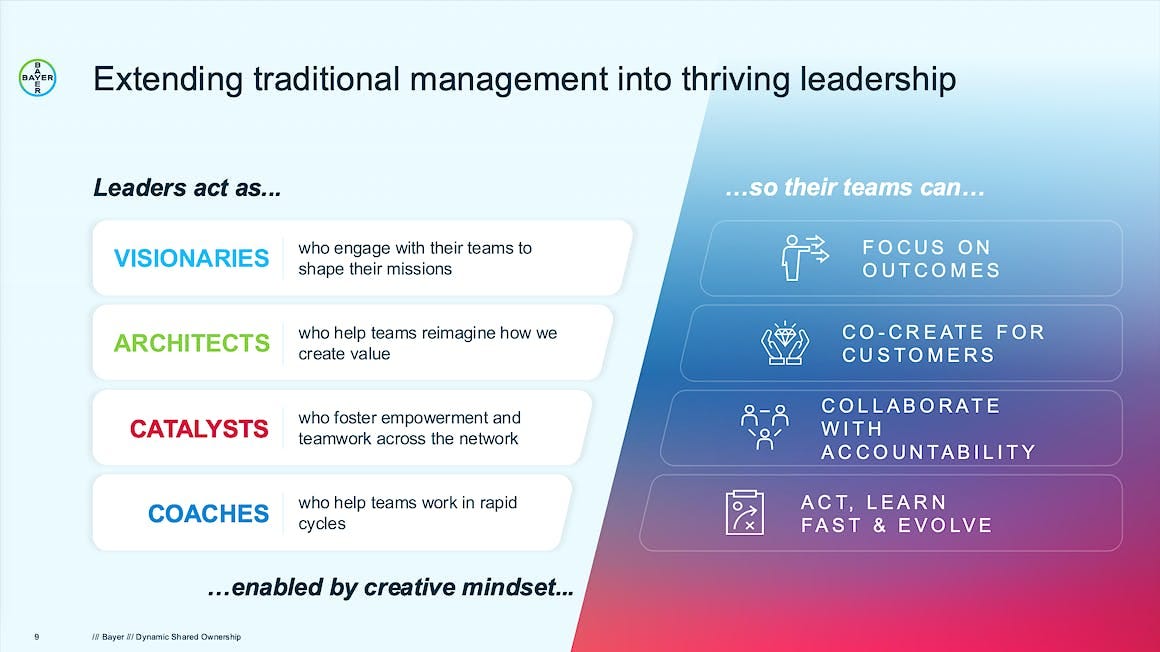🌿 OD113: Concepts and practical examples from Bayer's transformation
Insights from one of the boldest organizational transformations in history
As we’re witnessing one of the most daring transformation programs ever attempted, we share with you our notes and highlights from a recent Corporate Rebels session (see video and article) with Michael Lurie, Chief Catalyst at Bayer and Lars Bruening, Bayer's Pharma division transformation leader.
⚛︎
The conceptual backbone of the DSO Dynamic Shared Ownership approach that is being implemented in Bayer seems to be a mix of:
Humanocracy: Creating Organizations as Amazing as the People Inside Them by Gary Hamel and Michele Zanini
Gary Hamel was invited to talk about the fundamentals of humanocracy in the official Bayer webinar about DSO (min 2:40-19:25)
New leadership for a new era of thriving organizations by McKinsey partners Aaron De Smet, Arne Gast, Johanne Lavoie, and Michael Lurie (ex-McKinsey partner)
Team of Teams: New Rules of Engagement for a Complex World by Stanley McChrystal and other platform/network models like RenDanHeYi or Market-Oriented Ecosystems
⚛︎
Let’s take a closer look at what Michael Lurie and Lars Bruening shared during the Corporate Rebels session.
Michael Lurie intro
Bayer - leading Life Sciences organization
160 years, 100000 people, 3 businesses
New CEO joined in middle of 2023 - brought with him quite a revolutionary vision for evolving the organization, to unleash its full potential
Key concept introduced: Dynamic Shared Ownership
Previous experience of bringing this kind of vision: 6 years in an organization in Russia
Why DSO?

”Why DSO? We are unleashing the full potential of Bayer to create new levels of value for our stakeholders
For Customers: World-Leading Innovation
Stronger focus on customer needs with autonomous, dedicated product and customer teams
Increase speed to market with faster innovation cycles
For Employees: Productive, Fulfilled People
Removal of bureaucratic, time-consuming tasks that don't add value
More dynamic resource flow to highest-impact priorities
A more fulfilling and inclusive place to work
For Investors: Superior Financial Performance
Cost efficiencies with the elimination of roles, processes and activities not focused on our mission
€2bn in sustainable organizational savings by end of 2026”
What is DSO?
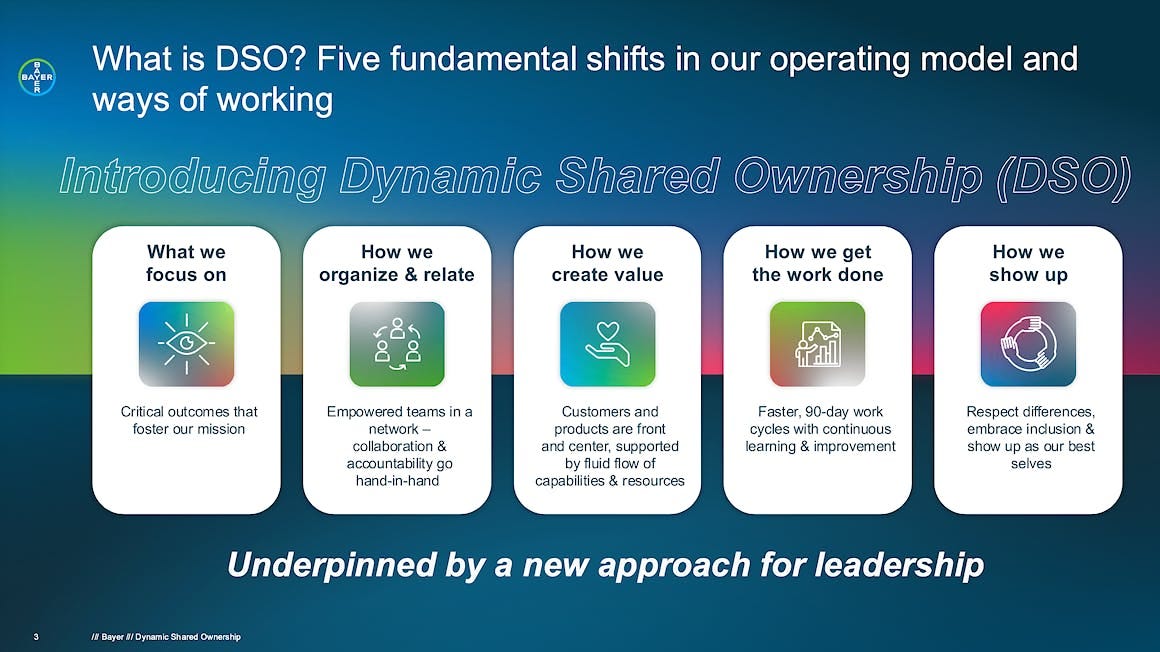
”What is DSO? Five fundamental shifts in our operating model and ways of working
What we focus on: Critical outcomes that foster our mission
How we organize & relate: Empowered teams in a network - collaboration & accountability go hand-in-hand
How we create value: Customers and products are front and center, supported by fluid flow of capabilities & resources
How we get the work done: Faster, 90-day work cycles with continuous learning & improvement
How we show up: respect differences, embrace inclusion & show up as our best selves
Underpinned by a new approach for leadership.”
1. What we focus on
”What we focus on: every team focuses on creating value
From: Many misaligned KPIs focused on tasks and deliverables - Market share, Customer call rate, Volume of products sold, Resources consumed, Inventory levels, Throughput time, Equipment utilization time, Hours worked, Quality metrics, Compliance metrics, Accounts receivables days, Accounts payable days, ...
To: Simple, clear and aligned mission and outcomes:
Today
Short-term outcomes: What we will deliver in the next 90 days
Mid-term outcomes: What we aim to achieve in the next 1-3 years
Long-term outcomes: Our ambition 5 years from now
Mission: Health for All, Hunger for None (overall aspiration of value that we want to create)”
Michael Lurie (concept):
"Besides the organizational mission, we have missions at each level in the organization, including each team starting to craft a mission for themselves and we translate those into outcomes.
Outcomes are the actual value you want to create for stakeholders, long term, mid term and short term."
Lars Bruening (practical example):
"When we started working with teams on what are really the outcomes that you go for, some felt 'Ok, now we have a new definition of our objectives, we need to rewrite our objectives in a different format.'
That is to some extent true, but that is not the power of this new approach. The approach is really: we focus on the outcomes, we look at what really matters.
Let me give you the example of one of our key oncology products, where we have just had a set of new clinical data coming out. So in the pharmaceutical industry, clinical data phase two or phase three is in oncology when you can prove that the product prolongs lives of people. This is the biggest moment you have, and you want to translate those clinical data as quickly as you possibly can into an indication so that doctors can start prescribing the product for the patient and start saving lives.
Now, in anticipation of this data reveal coming, and then this process of how fast do we get it to the regulatory authorities, so they can review and approve, the new Becca team in the new setup went into saying: 'If you focus on the outcome to get this set of clinical data as quickly as possible in high quality to the regulatory authorities, what do we really need to do out of all that we've been doing so far and what could we possibly drop because it served more maybe internal purposes than really the outcome?'
And they found out there were layers of different reviews always done in these processes, layers in the hierarchy, every level of hierarchy wanted to have their reviews. There were maybe cross-functional committees that wanted to look at it.
They really went and said: we absolutely need to make sure we have the quality and the speed and took out lots of internal steps, and took out 800 documents that would have been otherwise created purely for internal purposes, that weren't related to outcome.
So when you challenge this document and said: where does this help getting this faster in quality to the regulatory authorities and nobody had an answer, skip it.
That is the power of outcomes and wording them. And that's where this focus shapes and changes the organization."
2. How we organize and relate
“How we organize and relate: collaborative network of autonomous teams
From: Traditional hierarchy of individuals
Working in siloes
Slow, less-efficient
Top-down management
Reducing layers from 12-13 to 6-7
Shifting from span of control of often 3-5 to span of coaching of 15-30+
Establishing peer accountability and transparency between teams
To: Thriving network of teams with transparency, freedom and accountability
Small businesses & functional units with decision-making power focused on customer value
Empowered cross-functional teams supply expertise and support flowing to where they can add most value
Leadership teams support in setting vision, empowering and coaching teams, and enabling resource flow”
Michael Lurie (concept):
"Traditional organizations really operate as a hierarchy of individuals. Emphasis on the individual job and responsibility and it really works through a hierarchy. Who you report to is most important and determines really how everything gets done.
We're shifting to an open, collaborative network of teams. So the core unit of work is becoming a team. And we're building thousands of autonomous self-managing teams across the organization. Teams that are cross-functional, that work with high trust and psychological safety, that take on accountability and collaborate horizontally across the organization."
Lars Bruening (practical example):
"This is about collaborating in teams and across teams. Teams collaborate horizontally, they don't always need hierarchy. In the past, it was always the hierarchy that coordinated between them. They don't need that anymore. They shouldn't even try and use it. They should just coordinate between themselves.
A great example is another product launch, where we had a new formulation for a product and we got a real hiccup because some of our suppliers in that product supply manufacturing process had a warning letter from the FDA, the US regulatory authority, and it threatened to delay the whole thing.
Once this was cleared, we had a major setback in terms of the timelines and the teams were given the freedom to not go through hierarchy again, but to relate directly to what needed to be done and an enormous energy built up between them and we could eventually achieve our original timelines and start treating patients in a record time.
It was at the beginning of this year (2024) that this started and it was that very open collaboration between the teams, listening well to one another, not one pushing something on the other, but listening well to get the things right together, this is how we organize and relate and not refer back to hierarchy."
3. How we create value
”How we create value: placing customer and product teams at the center, enabled by fluid capabilities and resources.
From: Capturing existing value through large functions hard-wired for scale
To: Co-creating new value through entrepreneurial micro-businesses working directly with customers
Customer and product teams of ~6-10 people provide an evolving portfolio of solutions to an evolving array of markets
Delivering: Speed, Innovation and Profit
Technical and enabling teams of ~6-10 people secure, enrich and flow resources and expertise to product and customer teams
Delivering: Expertise, Capability and Capacity”
Michael Lurie (concept):
"In a traditional organization, creating value is more anchored around large functions and hardwired into each of those functions are a whole set of processes and systems designed for scale. Which leads to efficiency, but makes it very hard to adjust & adapt.
Within the network that we create across the organization, we're already focusing on four sets of teams in order to create value. We're centering around customer teams and product teams, focusing on engaging with customers and developing and delivering products. And those are the core kind of teams - we'll be setting up about 2000 customer and product teams across the organization. We're in the process of doing that. We're about halfway done with that process at this point.
And then we have technical teams responsible for building capabilities and R&D, product supply and commercial, and enabling teams aggregating resources and HR and finance and IT and other areas. These teams flow the capabilities and resources to the customer and product teams.
Within every team, there's also a strong focus on value creation: who are we serving? what is the value we are creating for them? what are the resources we're using? and how do we do that in a way that creates maximum value for stakeholders?"
Lars Bruening (practical example):
"How we create value? Again, by not necessarily looking at what's the budget that we need to fulfill, but by looking at where is maybe the unmet customer need that we have.
My example relates to a hemophilia product where bleeding patients inject themselves to prevent bleedings. In one situation in Italy, they often need to use two vials for that injection. So the local team has always complained: the customers are complaining about that it's not easy on them. What can we do? Can we change the vial formulation? Can't we do bigger vials? and Global said: yes, we can, this is very important, it takes until end of 2026 and then you have the new vials.
So that was always frustrating on our own people in the country, and on the customers, on the patients, because it was really tedious on them.
With the new freedoms of working differently and doing stuff, whenever it's medically and customer wise, they started thinking: how can we help them deal with the two vials if they can't change the two vials into one? And they created something very simple: a holder for the two vials that is printed by 3D printer. Very simple process, this costs 6 euro.
They created this, they clarified that with their local Medical Affairs for quality and making sure nothing wrong is happening with the patients and went to using this for patients. Feedback from patients has been "wow, you as a company really have us in mind".
Admittedly, they would probably have preferred the bigger vial, but they saw that this really helps in holding these vials and the whole process gets much easier.
In the past, introducing them, it would have taken the Italy team a year, a year and a half minimum to go through all the other processes. Medical Affairs would have gone to Regional Medical Affairs, who would have gone to Global Medical Affairs.
Hierarchies have an in-built tendency to reduce or avoid risks, so it could have well failed in the process, in the nowhere, somewhere. It didn't in the new setting and it's really been a breakthrough also in the market position that we have there."
4. How we get work done
”How we get work done: rapid cycles of decision, action and learning
From: Traditional linear annual planning
To: Rapid 90-day cycles with quarterly retrospectives
Define and prioritize highest-impact outcomes
Identify available capacity & skillsets
Emphasize quick, efficient and continuous decision making
End each cycle and begin the next with a retrospective”
Michael Lurie (concept):
"There's a shift in traditional organization from annual planning, done in a pretty linear way to working in rapid cycles.
So we're shifting the whole company to work in 90-day cycles. Every team, every unit, the whole organization is trying to work in this very rapid, 90-day rhythm, with a strong emphasis on making quick decisions, testing and learning, and constantly iterating and evolving. So it's really building a learning organization.
At the end of every 90 days, every team across the organization holds a retrospective to reflect on what went well, what needs attention, what are we going to adjust in the next 90 days. And obviously these ladder up to the outcomes that every team is focused on."
Lars Bruening (practical example):
"It's all about being fast, not planning to the very end and last detail, but get going, testing it out, learning, adjusting, going on.
We had a tendency in this company, I think we have it in many big companies to always try and plan perfect, with our strategic planning, with our operational planning. We try and plan a whole year, 18 months before it finishes. So in the middle of the year, we plan the next year.
We are doing away with this. Not completely yet, but we're in the process of doing away with this, and rather looking at what is it that we need to do and want to do in the next 90 days. If we project from the past what is happening in the next 90 days, what does that look like. How can we influence it, how can we change it towards our objectives in a better way.
And 90 days later we can adjust again. So we're not trying to describe a future that we don't know yet, but to deal today with a clear view of the outcomes that we have in mind.
So these 90 days matter a lot. Also, we have this flow of the resources to where they are best needed.
Our US commercial team have a fantastic process, they call it the 'brand marketplace', where people who used to be dedicated to individual brands in the past, and they were locked in boxes in an org chart, now they are all one group. The group discusses the priorities for the next 90 days and then they position themselves in a room to try and support these priorities. So they allocate themselves to where they think they can add the biggest value and moves the biggest overall effect that Bayer has for our customers, our patients. Move that best possibly forward in the next 90 days.
So, again, 90 days helps for budget allocation, but also for people and internal resource allocation and creates the level the abundance for the products or activities where everybody agrees they are a priority. And through that, it increases the flow and the impact."
5. How we show up
”How we show up: bringing our whole best selves to thrive and succeed, individually and collectively
From: Traditional reactive mindsets - To: DSO creative mindsets
What we focus on: from preservation to possibility
How we organize: from authority to partnership
How we create value: from scarcity to abundance
How we get work done: from certainty to discovery
How we shoup up: from conformity to self-authorship
Shifting our consciousness to a creative, aware mindset will allow us to embody all the DSO principles and to be our best selves.”
Michael Lurie (concept):
"This is about the shift in mindset from what we call a sort of a reactive mindset underpinned by limiting beliefs (...) to inviting to embrace a more creative mindset based on enabling beliefs."
Lars Bruening (practical example):
"This is so, so important. It's in the teams, where you don't have the bosses watch out, are you doing everything right and yes, I approve / I don't approve. It's the teams that say "we do this". And the teams can only do this with confidence if they have listened to everybody who has the cross functional perspectives. So having everyone chime in, doing rounds and making sure that really everybody speaks out is so important.
You know this from all the theory on dysfunctional teams how important it is to create trust and have everybody chime in and commit results-focused. That's what we support with this principle. We see a huge difference.
Recently, I was in Portugal, visited our Farmer teams there. They have made such a progress over the last years in terms of developing that. The way that they collaborate in their teams, the openness they have, the fun, the joy that they have, the feedback that they get from the customers, the business development is fabulous versus also other countries. So they're really doing very well.
And the best thing i heard there was one colleague saying: You know what, since we work this way, the Sunday evening blues is gone. So you see the power of this.”
Extending traditional management into thriving leadership
Michael Lurie (concept):
"Underpinning all of this is a new approach to leadership. We talk about VACC: Visionaries, Architects, Catalysts and Coaches. Each of these dimensions reflects one of the principles we just mentioned.
As Visionaries, leaders help teams focus on mission and outcomes.
As Architects, they help teams think about how they're going to create value with a focus on customers and products.
As Catalysts, they help teams work with high accountability and autonomy and collaborate across the network.
As Coaches, they help teams operate in those 90-day cycles, constantly learning and evolving.
And all of these are underpinned by the creative mindset."
Transformation phases
Phase 1:
Mid '23 - Mid '24
Frontrunners - First leadership and operating teams to pioneer the new ways of working
Architecture - High level architecture of new operating model in each division and the enabling functions
Phase 2:
Mid '24 - End '25
Accelerate to impact - Bring selected customer, product and technical teams to full proficiency, supported by new systems
Steady enterprise roll-out - Steady roll out of DSO architecture and mindset/new ways of working enterprise-wide
Phase 3:
+2026
Full realization - Bring full organization to proficiency to realize new levels of growth, profitability and cashflow
Other notes from the Q&A with Michael and Lars
”Focus of leaders: sensing the system, guiding the system and enabling and unleashing people. So it's a very different construct of leadership.”
”Is the interaction between teams happening? Do they have all the information they need to make decisions? We want to make sure that the operational teams have the information to make decisions. The task of leadership is to arrange for it, to make it happen."
”IT Tool: Talent Marketplace, where people can be informed about and see projects that are looking for support”
”A lot of personal skills people need to develop in order to make this system work”
”Community of 200+ practitioners dedicated to DSO, who are working with teams to help them launch them, learn and apply the principles of DSO, focused on high leverage teams”
”Amplified with a community of champions or DSO enthusiasts - aspiration: in every team. Someone who is most passionate about DSO, constantly learning about DSO”
”Dozens of leadership teams involved in co-creating the architecture of the organization”
”Company facing existential challenges (…) Vision of DSO being the primary vehicle through which we're going to address all these issues and unleash the full potential of the organization”
”For each team: 18 months journey to become proficient
Start with an onboarding workshop: 2-3 days - typically with a practitioner coach or championsintroduce to basic principles of DSO - in the context of their team
draft mission for the team
set the first 90 day outcomes
conversations around questions like: how do we start working more as a team? how do we actually start having accountability as a team? what are the key things we need to focus on to deliver value? what do we need to stop doing?
Practitioner/champion will continue to work with that team for a period of time, typically for at least 6 months, maybe longer. Primary direct vehicle for support.
On top of this, we have leaders who show up as VACC leaders and seeking to be of service to the team, actually working with the team, helping them get skills and capabilities around what they're doing.Plus hundreds of pages of materials, self-learning programs.”
”DSO-in-a-box: self learning programs for teams to learn the basic principles DSO. What is an outcome? How do you build psychological safety and trust as a team? What does it mean to conduct a retrospective every 90 days - basic practices that people can learn for themselves and then help each other learn.”
⚛︎
Further reading
Bayer: Mission and Strategy - corporate page
Lizzie Benton: An Analysis of Bayer’s Radical Move to Dynamic Shared Ownership - blog article
Niels Pflaeging: Bayer's DSO initiative as promoted by CEO Bill Anderson comes with all the right intentions. With the right methods, it is both realistic and feasible - Linkedin article
Lisa Gill: Reinventing big pharma: Bayer’s shift towards Dynamic Shared Ownership - Medium article
Dan Pontefract: How Bayer's Dynamic Shared Ownership Just Might Be A Flat Army - Forbes article
Tamer Labib: Leap Before You Look - A Team's First Step In The Dynamic Shared Ownership "DSO" Journey - LinkedIn article
Brent Massman: A Distinguished Expert and Senior Science Fellow’s Observations and Insights about Bayer’s DSO Reorganization - LinkedIn article
OD Insights is a series exploring Org Design & Development 🌿
Published by: Raluca and Bülent Duagi, the Sense & Change team. We advise and facilitate the strategy and org design work of sr. leadership teams in the Romanian Tech sector.


